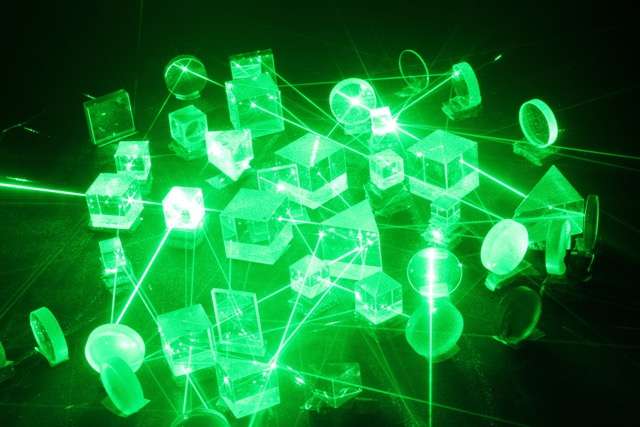Quantum physics inside a drop of paint

Inside a drop of paint, light is scattered so often that it seems impossible to demonstrate quantum effects. But despite the thousands of possible paths the light can take, like a drunk person inside a labyrinth, researchers of the University of Twente now show that there are just two exits. Depending on the light pattern that enters the paint, two photons always come out through the same exit, or through different ones – as though they avoid each other. The scientists of UT's MESA+ Institute for Nanotechnology publish about these remarkable findings in the Physical Review A journal.
The millions of particles inside a drop of dry paint, scattering light in many random directions, seem to make it truly impossible to prove any quantum effect. Most of the experiments showing that light sometimes behaves like a wave and sometimes like a particle, are as simple as possible: a physics textbook example is Young's two slit experiment. The number of possible light paths is limited, but even at this level, the experiments strongly challenge our intuition.
Tom Wolterink and his colleagues at the University of Twente, nevertheless, prove that two photons – light particles – falling on a drop of paint, can just leave through two possible exits. According to the so-called 'Hong-Ou-Mandel effect', the photons come out through one of the two exits at the same time. Which one that will be, cannot be predicted beforehand. It is as if you send two drunk people into a labyrinth, and they always leave through one door arm in arm.
The University of Twente researchers succeed in this by programming the light in a very smart way. It is possible to influence scattering and interference inside the paint, limiting the number of exits to just two, even when there are thousands of possible paths.
Programming the incident light in a slightly different way, results in the opposite. The number of exits is still two. But if photon one leaves through one exit, photon two always leaves through the other. Which one will go through which exit is not known, but the photons always seem to avoid each other: a counterintuitive result again, because weak light pulses don't 'feel' each other's presence.
Controlling quantum light effects like in the new experiments, opens new possibilities in quantum computing and advanced security techniques like a 'quantum credit card'.
More information: 'Programmable two-photon quantum interference in 10^3 channels in opaque scattering media' by Tom Wolterink, Ravitej Uppu, Georgios Ctistis, Willem Vos, Klaus Boller and Pepijn Pinkse. Physical Review A, May 11, 2016. arxiv.org/abs/1511.00897
Journal information: Physical Review A
Provided by University of Twente




















